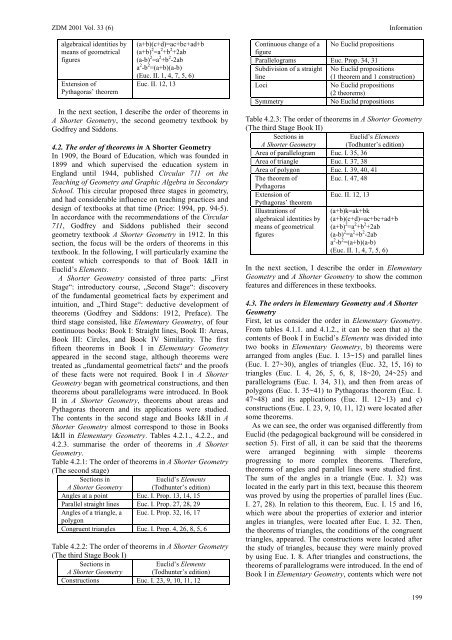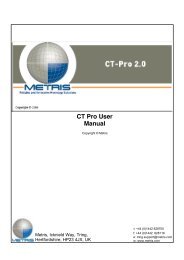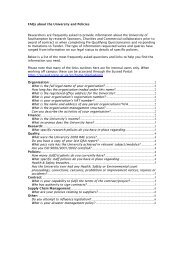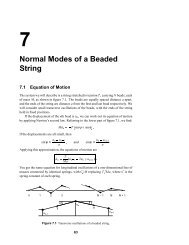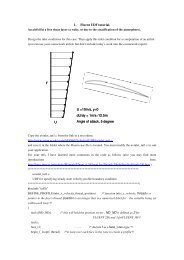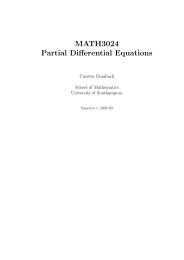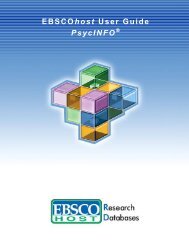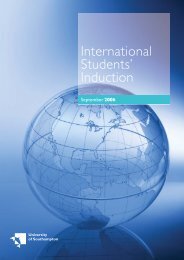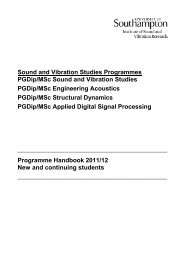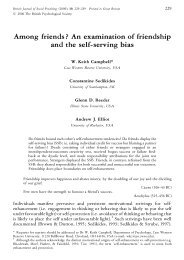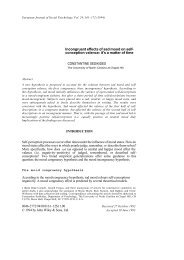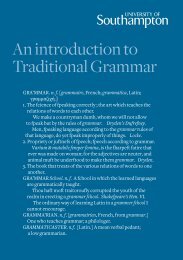1. Introduction - University of Southampton
1. Introduction - University of Southampton
1. Introduction - University of Southampton
Create successful ePaper yourself
Turn your PDF publications into a flip-book with our unique Google optimized e-Paper software.
ZDM 2001 Vol. 33 (6)<br />
algebraical identities by<br />
means <strong>of</strong> geometrical<br />
figures<br />
Extension <strong>of</strong><br />
Pythagoras’ theorem<br />
(a+b)(c+d)=ac+bc+ad+b<br />
(a+b) 2 =a 2 +b 2 +2ab<br />
(a-b) 2 =a 2 +b 2 -2ab<br />
a 2 -b 2 =(a+b)(a-b)<br />
(Euc. II. 1, 4, 7, 5, 6)<br />
Euc. II. 12, 13<br />
In the next section, I describe the order <strong>of</strong> theorems in<br />
A Shorter Geometry, the second geometry textbook by<br />
Godfrey and Siddons.<br />
4.2. The order <strong>of</strong> theorems in A Shorter Geometry<br />
In 1909, the Board <strong>of</strong> Education, which was founded in<br />
1899 and which supervised the education system in<br />
England until 1944, published Circular 711 on the<br />
Teaching <strong>of</strong> Geometry and Graphic Algebra in Secondary<br />
School. This circular proposed three stages in geometry,<br />
and had considerable influence on teaching practices and<br />
design <strong>of</strong> textbooks at that time (Price: 1994, pp. 94-5).<br />
In accordance with the recommendations <strong>of</strong> the Circular<br />
711, Godfrey and Siddons published their second<br />
geometry textbook A Shorter Geometry in 1912. In this<br />
section, the focus will be the orders <strong>of</strong> theorems in this<br />
textbook. In the following, I will particularly examine the<br />
content which corresponds to that <strong>of</strong> Book I&II in<br />
Euclid’s Elements.<br />
A Shorter Geometry consisted <strong>of</strong> three parts: „First<br />
Stage“: introductory course, „Second Stage“: discovery<br />
<strong>of</strong> the fundamental geometrical facts by experiment and<br />
intuition, and „Third Stage“: deductive development <strong>of</strong><br />
theorems (Godfrey and Siddons: 1912, Preface). The<br />
third stage consisted, like Elementary Geometry, <strong>of</strong> four<br />
continuous books: Book I: Straight lines, Book II: Areas,<br />
Book III: Circles, and Book IV Similarity. The first<br />
fifteen theorems in Book I in Elementary Geometry<br />
appeared in the second stage, although theorems were<br />
treated as „fundamental geometrical facts“ and the pro<strong>of</strong>s<br />
<strong>of</strong> these facts were not required. Book I in A Shorter<br />
Geometry began with geometrical constructions, and then<br />
theorems about parallelograms were introduced. In Book<br />
II in A Shorter Geometry, theorems about areas and<br />
Pythagoras theorem and its applications were studied.<br />
The contents in the second stage and Books I&II in A<br />
Shorter Geometry almost correspond to those in Books<br />
I&II in Elementary Geometry. Tables 4.2.<strong>1.</strong>, 4.2.2., and<br />
4.2.3. summarise the order <strong>of</strong> theorems in A Shorter<br />
Geometry.<br />
Table 4.2.1: The order <strong>of</strong> theorems in A Shorter Geometry<br />
(The second stage)<br />
Sections in<br />
A Shorter Geometry<br />
Euclid’s Elements<br />
(Todhunter’s edition)<br />
Angles at a point Euc. I. Prop. 13, 14, 15<br />
Parallel straight lines Euc. I. Prop. 27, 28, 29<br />
Angles <strong>of</strong> a triangle, a Euc. I. Prop. 32, 16, 17<br />
polygon<br />
Congruent triangles Euc. I. Prop. 4, 26, 8, 5, 6<br />
Table 4.2.2: The order <strong>of</strong> theorems in A Shorter Geometry<br />
(The third Stage Book I)<br />
Sections in<br />
Euclid’s Elements<br />
A Shorter Geometry (Todhunter’s edition)<br />
Constructions Euc. I. 23, 9, 10, 11, 12<br />
Information<br />
Continuous change <strong>of</strong> a No Euclid propositions<br />
figure<br />
Parallelograms Euc. Prop. 34, 31<br />
Subdivision <strong>of</strong> a straight<br />
line<br />
No Euclid propositions<br />
(1 theorem and 1 construction)<br />
Loci<br />
No Euclid propositions<br />
(2 theorems)<br />
Symmetry<br />
No Euclid propositions<br />
Table 4.2.3: The order <strong>of</strong> theorems in A Shorter Geometry<br />
(The third Stage Book II)<br />
Sections in<br />
Euclid’s Elements<br />
A Shorter Geometry (Todhunter’s edition)<br />
Area <strong>of</strong> parallelogram Euc. I. 35, 36<br />
Area <strong>of</strong> triangle Euc. I. 37, 38<br />
Area <strong>of</strong> polygon Euc. I. 39, 40, 41<br />
The theorem <strong>of</strong> Euc. I. 47, 48<br />
Pythagoras<br />
Extension <strong>of</strong><br />
Euc. II. 12, 13<br />
Pythagoras’ theorem<br />
Illustrations <strong>of</strong><br />
algebraical identities by<br />
means <strong>of</strong> geometrical<br />
figures<br />
(a+b)k=ak+bk<br />
(a+b)(c+d)=ac+bc+ad+b<br />
(a+b) 2 =a 2 +b 2 +2ab<br />
(a-b) 2 =a 2 +b 2 -2ab<br />
a 2 -b 2 =(a+b)(a-b)<br />
(Euc. II. 1, 4, 7, 5, 6)<br />
In the next section, I describe the order in Elementary<br />
Geometry and A Shorter Geometry to show the common<br />
features and differences in these textbooks.<br />
4.3. The orders in Elementary Geometry and A Shorter<br />
Geometry<br />
First, let us consider the order in Elementary Geometry.<br />
From tables 4.<strong>1.</strong><strong>1.</strong> and 4.<strong>1.</strong>2., it can be seen that a) the<br />
contents <strong>of</strong> Book I in Euclid’s Elements was divided into<br />
two books in Elementary Geometry, b) theorems were<br />
arranged from angles (Euc. I. 13~15) and parallel lines<br />
(Euc. I. 27~30), angles <strong>of</strong> triangles (Euc. 32, 15, 16) to<br />
triangles (Euc. I. 4, 26, 5, 6, 8, 18~20, 24~25) and<br />
parallelograms (Euc. I. 34, 31), and then from areas <strong>of</strong><br />
polygons (Euc. I. 35~41) to Pythagoras theorem (Euc. I.<br />
47~48) and its applications (Euc. II. 12~13) and c)<br />
constructions (Euc. I. 23, 9, 10, 11, 12) were located after<br />
some theorems.<br />
As we can see, the order was organised differently from<br />
Euclid (the pedagogical background will be considered in<br />
section 5). First <strong>of</strong> all, it can be said that the theorems<br />
were arranged beginning with simple theorems<br />
progressing to more complex theorems. Therefore,<br />
theorems <strong>of</strong> angles and parallel lines were studied first.<br />
The sum <strong>of</strong> the angles in a triangle (Euc. I. 32) was<br />
located in the early part in this text, because this theorem<br />
was proved by using the properties <strong>of</strong> parallel lines (Euc.<br />
I. 27, 28). In relation to this theorem, Euc. I. 15 and 16,<br />
which were about the properties <strong>of</strong> exterior and interior<br />
angles in triangles, were located after Euc. I. 32. Then,<br />
the theorems <strong>of</strong> triangles, the conditions <strong>of</strong> the congruent<br />
triangles, appeared. The constructions were located after<br />
the study <strong>of</strong> triangles, because they were mainly proved<br />
by using Euc. I. 8. After triangles and constructions, the<br />
theorems <strong>of</strong> parallelograms were introduced. In the end <strong>of</strong><br />
Book I in Elementary Geometry, contents which were not<br />
199


